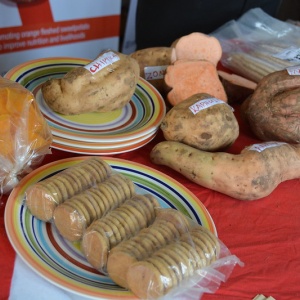
This paper argues that “agriculture for nutrition” interventions in low and middle income countries are overly narrow in scope and neglect the wider political, economic, social and cultural factors that affect food and (mal)nutrition.
Agriculture for nutrition encompasses two main approaches:
- Nutrition-sensitive value chains (NSVCs), a market-focused approach that aims to identify stages in the supply chain that can be used to improve nutritional outcomes, e.g. households increasing their consumption of nutrient-dense foods through increases in income, or the production, processing or transport of foods being made more efficient.
- Provision of biofortified crop varieties such as the orange-fleshed sweet potato (OFSP), which is high in beta-carotene.
The authors did not find any systematic review of the impacts of NSVC interventions on nutritional outcomes, partly because of the difficulty of attributing impacts to different simultaneous interventions. Six studies were found that cover more than one node in the supply chain, including:
- A study showing limited impacts of small-scale rural egg production centres in Zambia on household egg consumption and the height-for-age of children. The fact that benefits were limited was attributed to wider market dynamics including rising feed prices and barriers to accessing inputs.
- A study showing that food security increased (note that the paper Hambloch et al. says food security decreased, but this appears to be an error) for households participating in a project in Liberia that aimed to increase crop production and strengthen links between farmers, input suppliers and buyers, but that there was no statistically significant impact on children’s nutrition compared to a control group.
- Two studies showing that medium-sized businesses in Ghana and Nigeria struggle to provide nutrient-rich foods to poorer consumers while remaining profitable. Both studies conclude that public sector support is necessary.
- A study on UHT milk production in Pakistan, an intervention which failed to achieve its goal of increasing the supply of affordable dairy products to poorer consumers. The study notes that the UHT innovation instead contributed to the rise of non-dairy “tea creamers” (milk substitutes based on vegetable oils) with relatively little nutritional value.
- A study on the distribution of yoghurt fortified with iron, zinc, iodine and vitamin A in Senegal, which had insufficient impact on levels of anaemia in dairy-producing households and no statistically significant difference with the control group. Weather conditions were found to have an impact, with participation in the scheme decreasing in the dry season.
For crop biofortification interventions, specifically the orange-fleshed sweet potato, some studies show that OFSP interventions increased vitamin A intake in Mozambique, where impacts on vitamin A absorption and deficiency were not studied, and in Uganda, where impacts on serum retinol levels and vitamin A deficiency were found to be limited, partly complicated by infections among the study participants which made it difficult to compare results. Studies of OFSP interventions in Mozambique found that while they increased vitamin A intake, vitamin A deficiency remained high in one case and the likelihood of inadequate vitamin A intake remained unchanged in another.
The evidence on the impacts of OFSP projects on dietary diversity is mixed, with some studies showing no impact, some showing increases (although one study appears to be predisposed to showing an increase because the methodology counts fortified foods as a separate food category), and one showing a reduction. The lack of impact could be because of limited exposure to OFSP as well as to the low fat intake in the participants’ diets, which could reduce absorption of vitamin A.
In summary, the authors reflect that both NSVCs and OFSP interventions generally fail to deliver their intended outcomes because they do not address the structural root causes of malnutrition, such as the dominant role of the private sector in supplying food, low wages, limited access to resources and gender inequalities.
Abstract
Within the nutritionism paradigm, in this article we critically review the marketization and medicalization logics which aim to address the pressing issue of malnutrition in low- and middle-income countries. Drawing from political economy and food system transformation discourses, we are using the popular intervention types of nutrition-sensitive value chains (marketization logic) and biofortification exemplified through orange-fleshed sweet potato (medicalization logic) to assess their outcomes and underlying logics. We demonstrate that there is insufficient evidence of the positive impact of these interventions on nutritional outcomes, and that their underlying theories of change and impact logics do not deal with the inherent complexity of nutritional challenges. We show that nutrition-sensitive value chain approaches are unable to leverage or enhance the functioning of value chains to improve nutritional outcomes, especially in light of the disproportionate power of some food companies. We further demonstrate that orange-fleshed sweet potato interventions and biofortification more broadly adopt a narrow approach to malnutrition, disregarding the interactions between food components and broader value chain and food system dynamics. We argue that both intervention types focus solely on increasing the intake of specific nutrients without incorporating their embeddedness in the wider food systems and the relevant political-economic and social relations that influence the production and consumption of food. We conclude that the systemic nature of malnutrition requires to be understood and addressed as part of the food system transformation challenge in order to move towards solving it. To do so, new evaluation frameworks along with new approaches to solutions are necessary that support multiple and diverse development pathways, which are able to acknowledge the social, political-economic, and environmental factors and drivers of malnutrition and poverty.
Reference
Hambloch, C., Mausch, K., Conti, C. and Hall, A., 2022. Simple solutions for complex problems? What is missing in agriculture for nutrition interventions. Food Security, pp.1-17.
Read the full paper here. See also the TABLE explainer What is malnutrition?







Post a new comment »